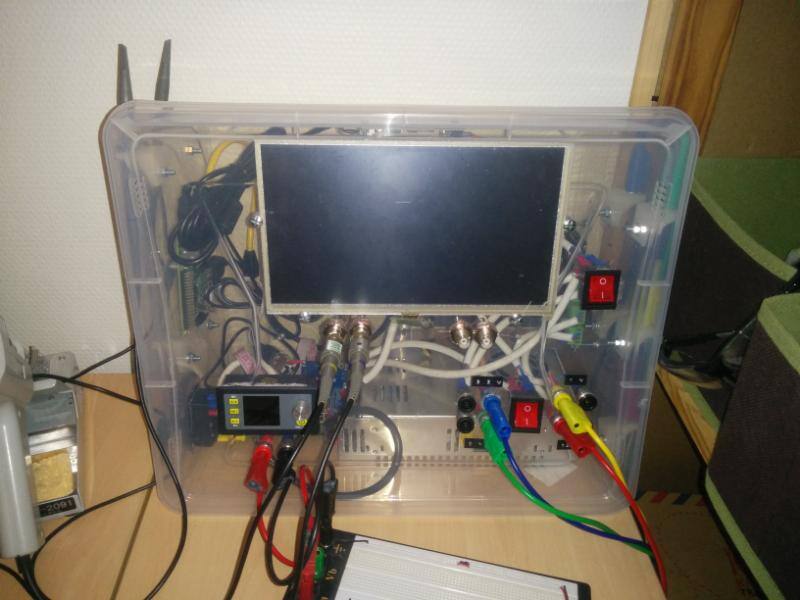Logic Analyzer Shield for a Red Pitaya Board
-
Posted by
 Red Pitaya Team
, July 9, 2024
Red Pitaya Team
, July 9, 2024

Introduction
As engineers and hobbyists, creating custom tools to enhance our projects can be both challenging and rewarding. In this blog, we discuss the development of a logic analyzer shield for a Red Pitaya board, a versatile open-source hardware project. This shield helps in capturing and analyzing digital signals, providing an affordable solution compared to commercially available options. The project involved circuit design, hardware assembly, software integration, and testing, resulting in a functional logic analyzer.
Project Overview
The idea stemmed from the need to extend the capabilities of the Red Pitaya STEMlab 125-14. Given its robust features, it was appropriate to utilize it as a logic analyzer. Initially, a 3D-printed case was considered, but a plastic one was used instead for better durability and ease of modification. The plastic case allowed for easy drilling and modification, accommodating connectors, switches, and other necessary components. This choice also provided better heat dissipation and structural integrity. The primary goal was to create a reliable and cost-effective logic analyzer using readily available components and open-source software.
Hardware Components
The success of this project relied heavily on the careful selection and integration of hardware components. The key components used in this project include:
- Red Pitaya STEMlab 125-14: This is the core of the project, providing the necessary processing power and interface capabilities to function as a logic analyzer.
- Arduino Uno: Used to generate test signals for initial testing and calibration of the logic analyzer.
- Custom Shield with Zener Diodes: This shield protects the inputs of the Red Pitaya from overvoltage, ensuring reliable and safe operation.
- Connectors and Wires: Essential for connecting the different components and ensuring proper signal transmission and power distribution.
Each component played a specific role, contributing to the overall functionality and reliability of the logic analyzer. The Red Pitaya board provided the processing and interfacing capabilities, while the Arduino Uno served as a test signal generator. The custom shield, with its protective Zener diodes, safeguarded the inputs, and the connectors and wires facilitated the connections between components.
Circuit Design
The design incorporates Zener diodes to protect the inputs. Each input channel is connected through a 220-ohm resistor to the cathode of a 1N4728A Zener diode, with the anode connected to the ground. This setup ensures that any voltage above 3.3V is clamped, protecting the Red Pitaya inputs from over-voltage. The resistors limit the current flowing into the Zener diodes, preventing damage from excessive current. This simple yet effective design ensures that the Red Pitaya can safely interface with a variety of digital signals without risking damage from voltage spikes.


Assembly
The components were carefully assembled on a prototype board, ensuring that all connections were secure and correctly placed. The assembly process involved soldering the components onto the board, connecting wires, and mounting the board inside the plastic case. The shield includes a UART/USB converter to facilitate communication with the computer, allowing for easy data transfer and control. Care was taken to ensure that the layout was clean and that there was enough space for future modifications or additions. The plastic case provided ample room for all components, with strategically placed holes for connectors and switches.


Testing and Results
The initial tests were conducted using an Arduino Uno to generate test signals. These signals were then captured by the Red Pitaya board and visualized using the built-in oscilloscope feature. The testing setup included connecting the Arduino to the custom shield and observing the signals on the Red Pitaya board's interface. The results were promising, with clear digital signals being captured. This initial success demonstrated that the basic functionality of the logic analyzer was working as intended. However, further tests revealed that the decoding of these signals did not work as expected, indicating that additional refinement and debugging were needed. Despite this, the project demonstrated the feasibility of using a Red Pitaya board as a logic analyzer.


Software Integration
The project explored using WaveForms, an open-source software from Digilent, compatible with the Digilent Instrumentation Protocol. The user adapted this software to enable the Red Pitaya board to capture and analyze signals. However, it lacked decoding capabilities, which led to the exploration of PulseView, software supporting the SUMP protocol. PulseView offers more advanced features for signal decoding and analysis, making it a suitable choice for this project. The integration of PulseView required implementing the SUMP protocol on the Red Pitaya board, allowing it to communicate effectively with the software. This integration enhanced the functionality of the logic analyzer by providing detailed signal analysis and decoding capabilities.
Conclusion
This project underscores the potential of Red Pitaya devices in extending their capabilities beyond the initial designs. Building a custom logic analyzer shield not only saves costs but also offers a tailored solution for specific needs. While there were challenges, such as signal decoding, continuous development and community support can address these issues. The project demonstrated the value of open-source hardware and software in creating versatile and cost-effective tools for engineers and hobbyists. For those interested, detailed documentation and source code are shared on Hackaday, while feedback and collaboration are welcome to further refine this tool. The journey of creating this logic analyzer shield is a testament to the ingenuity and resourcefulness of the engineering community, and to the versatility of Red Pitaya boards.
About the Red Pitaya Team
The Red Pitaya editorial team consists of engineers, researchers, and product experts who develop and test cutting-edge open-source test & measurement solutions.
Our mission is to make advanced instrumentation accessible to everyone — from students and educators to leading research labs worldwide.



